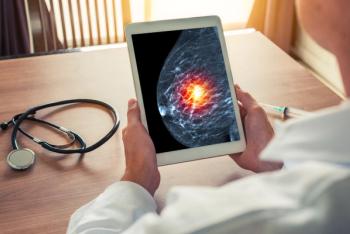Pharmacy Times interviewed Karline Peal, MBA, associate operating officer, Vanderbilt Ingram Cancer Center, Vanderbilt University Medical Center, who discusses the role of technological advancements within health care, which was the focus of her presentation at the ACCC National Oncology Conference. She emphasizes that technology can improve patient engagement and accessibility while reducing demands on clinicians, ensuring accurate documentation, and minimizing tedious tasks. Peal discusses the integration of technology in the cancer center, and notes that technology has the ability to create job opportunities, not erase them.
Pharmacy Times: How can technological advancements in robotics, chatbots, and AI-assisted clinical decision support tools help address challenges around staffing shortages?
Key Takeaways
- Utilizing Technological Advancements During Staffing Shortages: Technological advancements help address staffing shortages in health care by making operations more efficient and lessening the burden of repetitive tasks. These technologies help attract and retain employees in a competitive job market while enhancing productivity in the workplace.
- Improvements in Clinician and Patient Experience: Technological advancements have the power to improve the clinician experience by providing tools to improve diagnostic and patient care. Clinician burnout is reduced because technology helps them manage service demands and access resources while streamlining documentation processes and maintaining quality care.
- Integrating Technology into the Office: With these technological advancements, Peal notes that the cancer center has been able to integrate online scheduling, record retrieval, and data sharing into the practice, which increases patient satisfaction. Although there is concern that technology can replace job opportunities, it is more likely to create new roles within health care.
Karline Peal: So, when we think about staffing shortages today, it looks very different than the pandemic levels: we've seen a staffing shortage during the pandemic and continued onward, and I think many sectors are still struggling. I think in many ways, it's a good thing and a bad thing. Opportunities opened up for many people that prior existence did not have, the option to work remote or in different companies, and so, it's really opened a variety of options up your employees to pick and choose the fields they want to go into. So, it's definitely a more competitive landscape out there, and to that point, we have to adjust. We have to adjust how we manage our staff, we have to adjust how we recruit, and then how we implement technology and how we assist the technology that helps the employees that we have today to not only assess the work, but attract employees and retain them. I think that the workforce looks very different as it is coming in, the next generation grew up on technology and grew up on devices, so they're used to having things quick, and making their work fast and efficient. When we think about what work is going to look like 5 to 10 years for this population, I think it looks different than it did 5 to 10 years ago, and so, we have to keep up. They want to provide excellent care, quality of care, and have that engagement with our patients, and so, removing mundane or repetitive tasks is key and it’s important and vital to continue to sustain the competitive marketplace that we need to move forward.
I think the chat bots…that's also an interesting factor. We implemented 1 here in the community cancer center and we really weren't sure of it…and it's not marketed, so we do have engagement, which is great, we've seen patients who are looking for it and that's exciting because they want to access health care in a different way. So far, it’s not overly difficult to manage at this point, and we hope to build it up further so that we can meet future demands. What it’s supposed to do is drag patients to what they’re looking for. They don’t want to wait on hold, they want to be able to schedule online as quickly as possible and fit in their schedule versus waiting on a phone to talk to someone, maybe they're doing it in the middle of the night…that's where we end up finding the time to sit down to think about, “What do I need to do for myself?” And so, they go online and start searching, and chat bots are helpful in ways, and sometimes for certain populations it’s frustrating, but we're trying to do is tailor that experience and help drive into the resources that [patients are] looking for, and that’s what we’re trying to do. We're evaluating that data so that we can continue to improve our process and work to…looking forward.
Pharmacy Times: How can these technological advancements improve the clinician experience and help clinicians practice at the top of their license?
Peal: When I think about the clinician technology, it's vital. It's important as we share images in the future, what that looks like, providing them with the tools that they need to provide the care, we know that they have increasing demands on providing services and accessing care and resources for them as well, and so, technology is very important to the clinician, not only from a diagnostic perspective, but in helping clinicians, especially in communities where they might not have all the resources available to them. [Technology can] aid and support to improve clinicians' workload and to reduce burnout, [which] is vital to retaining clinicians in many facilities.
Also, flagging potential errors or inconsistencies on patients’ medical records and assisting the provider to improve upon it. There's an increasing demand on quality and accreditations and that requirement trickles down into the everyday work. So, how do we help the clinician maintain that interaction in that time? We need them with the patients face-to-face and reducing the burden of documentation and potential errors in billing, you want to make sure we have proper coding and compliance, but there's a lot of documentation that goes along with that. So, developing pathways and protocols for quality and safety mechanisms to reducing human errors is vital. Alerts, flags, reminders, smart phrases all help with consistent documentation and enforcing. And again, reducing the burden of administrative and repetitive tasks so that they can provide the care that our patients are seeking from them, and also, our clinicians want to get to know our patients as well, they want to spend the time with a patient, not in front of an EMR, where unfortunately, with all of the increasing workloads, it’s where [the clinician] has to be sometimes.
Pharmacy Times: How about nonclinical staff—how can these technological advancements help staff work at their highest skill set?
Peal: The nonclinical staff is really important in that they’re supporting the clinical team. That's a sector where we see a lot of competitiveness for that market of employees. There's a lot of opportunities for them to go into and retaining that staff is vital, so when you think about the nonclinical staff, how do we provide technology? You think about the advances we've made since the pandemic with online scheduling—we were barely scratching the surface with that before—but now you can go online scheduling your own appointments. Ultimately, [technology] reduces calls our call section and reduces waiting in a call queue, so increasing patient satisfaction. Streamlining record retrieval for [patients] is important in reducing the burden on the patient records, of the EMR optimization, sharing data between hospitals, file sharing, portals, data transferred, it speeds up all the time to treatment and access to care, which ultimately, trickles down to increasing and saving the provider time and then, in the end, improving patient health. So, it's vital to support the nonclinical staff, just as we do with the clinical staff.
Pharmacy Times: How can the use of business intelligence-assisted algorithms improve operations and reduce costs for oncology practices?
Peal: We’re all looking to see how we can reduce costs to patients and payers, and ultimately, improve our bottom line. Sustainability is going to be important, the largest part right now is inflation, supply demands are continuing to increase in costs, and so, how do we decrease costs and provide the services we need? When we look at certain communities, they're closing certain specialties because they just can't afford care, they can’t really afford to provide the care that they need, so, optimizing qualities and immediate access to data, we reviewed those outcomes and when you think about in cancer care, we've reached out to ask whether we have cancer link where when you look to benchmark our providers against others, it's important to evaluate our practice, how each of our providers are performing, the work that they need to do, and so, technology there allows us to evaluate each provider, is there any other tools we need to support them to provide the care that they need to meet the quality metrics that they need to do? And then, when you think about all that data obstruction that we were once doing manually, we were doing all that data extraction to find out, but then it wasn't real time either, it's months later after somebody was able to bring all the data, and so now, we have it in real time. It's wonderful, I get a morning report with all of our providers who are performing all the tasks that they need to do electronically, and so that we can provide the tools we need to for them.
So, I think business intelligence is important because it allows us to find the gaps that we have in an organization and provide the tools and invest in these tools properly. Again, when we think about patient satisfaction, it's real time now, same day, same power, feedback, whereas before it might take 30, 60, 90 days before you got that real time feedback—or delayed feedback, if you will—and know who's working that day. Was it raining? Was it snowing? Were there weather implications or staffing implications that day? What did the facility look like that day? It's really hard to go back that far and to try to fix the problems that we had…but when you have real time recording, we're able to rapidly make an improvement and know what's going on in the organization to make the changes you need for sustainability.
Pharmacy Times: How can electronic health records with advanced capabilities improve the patient experience, and what are some examples of how this can occur?
About the Expert
Karline Peal, MBA, is the associate operating officer of Vanderbilt Ingram Cancer Center, where she is responsible for administrative operations, oversight, and leadership of the Cancer Patient Care Center. As an associate operating officer, Peal works in collaboration with the associate nursing officer and other leaders in health care to improve performance as well as develop partnerships across Vanderbilt University Medical Center. Previously, Peal spent 17 years at Northwestern Medicine’s North Market Region where she worked in several leadership positions, and 8 years with the Advocate Health Care System as a manager of radiation oncology services.
Peal: I think we experienced this real time during the early days of pandemic. The entire file system, adopting telehealth platforms almost overnight to care for our patients, and this led to rapid adoption and acceptance of digital health, which led our organization through rapid improvement projects around advanced scheduling, appointment reminders, fast pass where a patient is able to jump ahead of the line if somebody cancels…in the past, that that appointment slot was empty, because no-one knew that tomorrow you have an opening someone just cancelled their appointment…so now, [patients will] get an automatic alert, “An [appointment] just opened, would you like to take it? Hit accept.” And then they can go in to see the provider. We’re able to communicate through text messaging with our patients when they're in clinic to inform them of any potential delays, so we're able to communicate, “Your doctor is running 15 minutes behind, we’ll be right with you.” And so, that interaction, that constant communication through technology enables an improvement in patient satisfaction and expectations.
Online scheduling, like I mentioned prior…it’s now 9 o'clock at night and the call center is closed, I want to schedule my appointment for a checkup, I'm able to go online and do that right from your smartphone, so it's really great. We’re now transforming that into virtual check-in so we're right in the process of patients being able to do all their pre-visit work to check in before they even walk in and when they arrive, they can click the button that they have arrived go in the waiting room. So now they don't have to wait in the line, and then this way, the clinic knows right away that the patient is ready to go see their providers that moves them up quicker. The online forms are filled down, so our intake process is complete, the copay is paid, It's another process where it's essentially a hard stop. Prior to that, patients might not pay their copay in-person…So, in many ways, it's just wonderful because it allows for additional improvements in financials, patient satisfaction, employee engagement, and retention.
I think the other thing I didn't touch on was the reminders. So, patient medication reminders, patient remote monitoring, as well, and so, it’s really important to improve outcomes if someone's alerts are changing in the middle of the night. The patient might not be aware that they're spiking a fever, but if you’re remote, you can quickly get them to phone call, because you see something changing. There's so much technology out there and you really have to assess what are your needs and where we really need a part to play.
Pharmacy Times: As fears continue regarding whether AI might replace jobs in health care, what is your perspective on this concern and its probability in the future?
Peal: I think everyone has those concerns, right? Whenever you're rolling out a technology, I think you have to be thoughtful on that process because what's in the delivery of that message. You're saying, “Well, I'm going to roll this out and it's going to eliminate this job function immediately.” And the person you’re talking to starts to think, “Well, how does that impact me? Do you still need me?” So, I think always when we think about rolling our technology out…it’s not to replace anyone because what we want ultimately is to improve the patient's experience. So, the technology is maybe providing us more data, maybe it's feeding us information that we didn't know before. So, I don't think it's going to replace, I think it will create opportunities for new positions as new roles will emerge with every major technological changes. So, think a lot of AI development, data analytics, ethics, quality…there's just going to be a whole other area that will open opportunity. I think it will never replace empathy, critical thinking, and the human touch that health care providers offer.





